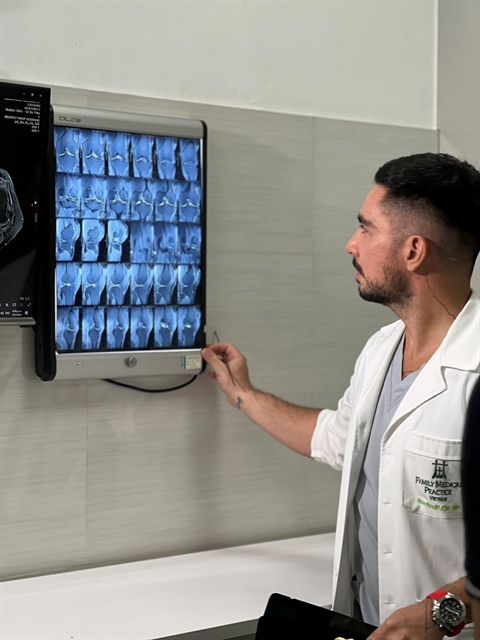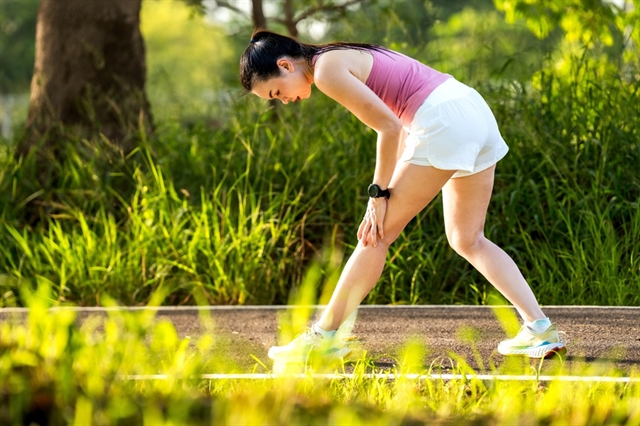
Dr. Andres Sosa. —Photo courtesy of Family Medical Practice
Dr. Andres Sosa*
If you’re an active athlete or runner or know someone who is, chances are you’ve heard about the meniscus. In the first part of this series of three articles, we introduced information about what a torn meniscus is: a common knee injury that can occur in active athletes or runners.
The meniscus, located within the knee joint, provides stability and acts as a shock absorber during activities.
There are different types of meniscal tears, including vertical, horizontal, bucket-handle, vertical radial and complex tears. The specific type of tear influences treatment options and outcomes.
Symptoms of a meniscus tear may include knee pain, swelling, knee instability, a locking sensation, limited range of motion and difficulty bearing weight.
It's important to note that not all meniscal tears exhibit noticeable symptoms, and some may heal on their own without intervention.

If you’re an active athlete or runner or know someone who is, chances are you’ve heard about the meniscus. — Photo shutterstock.com
Now we have established what it is, let’s have a closer look at what causes it.
There are three most common causes of a Meniscus Tear:
#1: Overuse
Overuse is the primary cause of this injury and is a common factor in most running-related injuries. It accounts for up to 80 per cent of all running injuries.
The extent of overuse varies for each individual, depending on the stress endured by the body and subsequent recovery.
It can take a lot of mental fortitude to push hard during a run, particularly when you are just starting out. But sometimes, it is not good to push above the capacity of our body but to resume physical activity progressively.
Our bodies can adapt to do amazing things, but we have to give them the right mixture of stimulus, rest and nourishment.
Run easy and often. In recent years, studies have shown that, on average, optimal training intensity is achieved when runners perform around 80 per cent of their training sessions at low intensity and 20 per cent with high-intensity work.
You can measure how “intense” your running session is by the rate of perceived exertion (RPE) or by using a heart rate monitor.
If we continue to run at an effort level above the body’s capacity, it will cause excessive muscle stress and inflammation, possibly resulting in over-training and frustration.
#2: Muscle Weakness
Weak muscles surrounding the knee can compromise the level of support, stability, and alignment of the knee joint.
To tackle muscle weakness, runners should incorporate a well-thought-out strength and conditioning programme that will increase muscle strength and leave your body less susceptible to injury.
Incorporating a strength training programme into your routine involves utilising resistance training exercises to increase the strength of your muscles and connective tissues as a runner.
This can contribute to improved joint stability and a reduced likelihood of experiencing a meniscal tear. Furthermore, engaging in strength training exercises can assist in addressing muscle imbalances.
#3: Impact
A meniscus tear can occur when the femur and tibia undergo sudden and intense twisting motions under load during movements like jumping or collisions in contact sports.
In such cases, if the femur slides too far forward or backward in relation to the tibia, it can exert excessive force on the meniscus, leading to its rupture.
These twisting movements produce significant torque and are often the primary culprits behind meniscus tears.
In the next article, we will finally answer the question that has been on our mind since the start: is it ok to exercise with a torn meniscus?
In the meantime, listen to your knees! When it comes to meniscal tears, recognising the symptoms is crucial. If you're experiencing knee pain that sharpens with movement, swelling, a sense of unsteadiness, a locking sensation, limited range of motion, or difficulty putting weight on your leg, don't hesitate to seek medical attention. Early detection and intervention can prevent further damage and help you recover faster. Your doctor is your ally in this journey to regain knee health. Family Medical Practice
*Dr. Andres Sosa is our Orthopedic Surgeon specialising in sports medicine and trauma. After his residency in Orthopedics, he took a Master’s in Upper Limb Surgery at the University of Bologna (Italy). Furthermore, the Sports Medicine programme at Thomas Jefferson University in Philadelphia (USA) obtained his second Master’s in Shoulder Surgery with the University of Andalucía (Spain). Once in Việt Nam, he continued his surgical training with Arthrex ArthroLab (Singapore) focused on arthroscopic techniques for shoulder and knee injuries.
Dr. Sosa joined FMP in 2018 and is responsible for all orthopedic and trauma cases. He is also a sports nutrition expert from Major University (Chile) and is fluent in English, Italian, and Spanish.
Visit Family Medical Practice Hanoi 24/7 at 298I Kim Mã Str., Kim Mã, Ba Đình District.
To book an appointment, please call us at (024).3843.0784 or via Whatsapp, Viber or Zalo on +84.944.43.1919 or email hanoi@vietnammedicalpractice.com.
FMP’s downtown location in Hồ Chí Minh City is in Diamond Plaza, 34 Lê Duẩn Str., District 1, and 95 Thảo Điền Str., District 2. Tel. (028) 3822 7848 or email hcmc@vietnammedicalpractice.com.
OVietnam